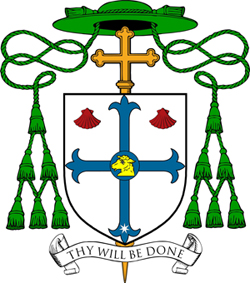Heraldic Achievement of
MOST REVEREND ROBERT J. BRENNAN
Titular Bishop of Erdonia
Auxiliary Bishop of Rockville Centre

Argent a cross flory azure throughout charged at the base point with a mullet of seven points of the field between in chief two escallop-shells gules, over all at the fess point a hurt charged with a lamb’s head couped Or.
In designing the shield—the central element in what is formally called the heraldic achievement—a bishop has an opportunity to depict symbolically various aspects of his own life and heritage, and particular elements of Catholic faith and devotion. The formal description of a coat of arms, known as the blazon, uses a technical language, derived from medieval French and English terms, which allows the appearance and position of each element in the achievement to be recorded precisely.
In Ireland, whence Bishop Brennan’s ancestors emigrated to the United States, coats of arms belong to a sept or family, rather than to an individual. The Brennan coat of arms (Argent, a lion rampant azure and in chief two dexter hands apaumée gules) comprises a white shield with a blue heraldic lion, and two red hands in the top corners of the shield. Rather than use the original design — the symbolism of which is somewhat obscure — Bishop Brennan has chosen to retain the overall coloration and layout of his family coat of arms, while employing charges more evocative of his own life of faith.
The main charge on the shield is the Cross, the foundation of the Christian faith. The arms of this particular Cross (called a cross flory) resemble a fleur-de-lis, a stylized lily often used as a symbol of the Virgin Mary. A cross flory (in black and white) also appears on the coat of arms of the Dominican Sisters whose schools the Bishop attended in his youth. Moreover, the shape of the crossbeams resembles the tail of the lion rampant that appears on the original family arms.
At the bottom of the cross appears a small white star (a mullet argent), another symbol of Our Lady. Its position recalls the moment of the Commendation, when, “standing by the cross of Jesus” (John 19:25), Mary became, at her Son’s command, the Mother of all of his disciples (cf. John 19:27). The star has seven points, recalling the seven Gifts of the Holy Spirit, and so is a fitting symbol of the one who is both “full of grace” (Luke 1:28) and who prays with the disciples of the Lord that they also may receive the promised gift of the Holy Spirit (cf. Acts 1:4, 8, 13-14).
At the center of the cross appears a lamb’s head painted gold (Or). The same charge figures prominently on the coat of arms of the Diocese of Rockville Centre, which Bishop Brennan has served as a priest for 23 years, and which he will now serve as Auxiliary Bishop. Because the Latin word for lamb is agnus, the gentle animal has long been a symbol of Saint Agnes, the twelve-year-old Roman martyr who suffered persecution and death in the early fourth century in defense of her faith and her virginity, which she had consecrated to Jesus Christ. Saint Agnes is the patroness of the Diocese, and of the Cathedral church, where Bishop Brennan resided for 16 years.
At the top of the shield (in chief) are two scallop shells painted red (gules). Although the charges are the same, they are used here to allude to two different saints: John the Baptist and James the Greater. Bishop Brennan attended Saint John the Baptist High School (West Islip) and Saint John’s University, and the patron of these schools is often depicted in sacred art using a shell to baptize the Lord Jesus. The date of Bishop Brennan’s ordination as a bishop — July 25, 2012 — is the feast of Saint James, the brother of Saint John the Evangelist and the first of the apostles to be martyred, during the persecution of the early Church (Acts 12:1-2). Medieval pilgrims to the shrine of Saint James in Compostella, on the northwest coast of Spain, would pick up scallop shells from the beaches and wear them on their cloaks or caps as a sign that they had completed the journey. The red color of the shells recalls the fact that both of these saints gave their lives as martyrs for the faith.
On a scroll below the shield appears the Bishop’s motto, “Thy will be done.” This petition from the Lord’s Prayer (Mt 6:10) summarizes and responds to the symbolism depicted on the shield. Standing with Our Lady by the Cross of the Lord, and recognizing he is called to “drink the cup” of the Lord’s suffering by bearing his own cross (cf. Mark 10:38-39), a disciple must rely on the Lord for strength and make his own Jesus’ words in the Garden: “Not my will but yours be done” (Luke 22:42).
The shield is ensigned with external elements that identify the bearer as a bishop. A gold processional cross appears behind the shield. The galero or “pilgrim’s hat” is used heraldically in various colors and with specific numbers of tassels to indicate the rank of a bearer of a coat of arms. A bishop uses a green galero with three rows of green tassels.
